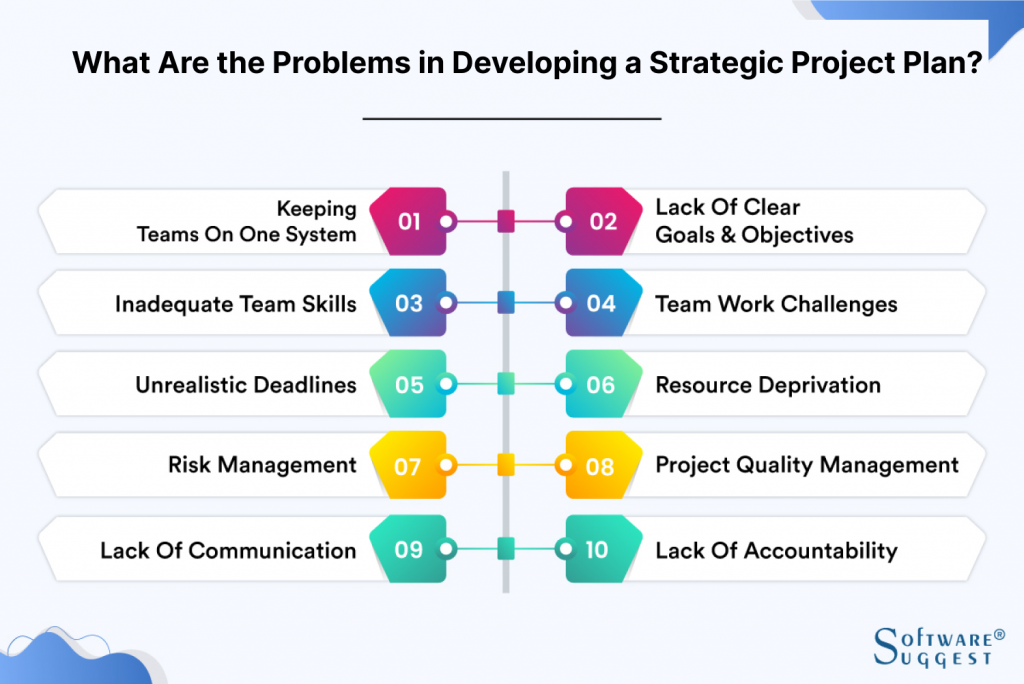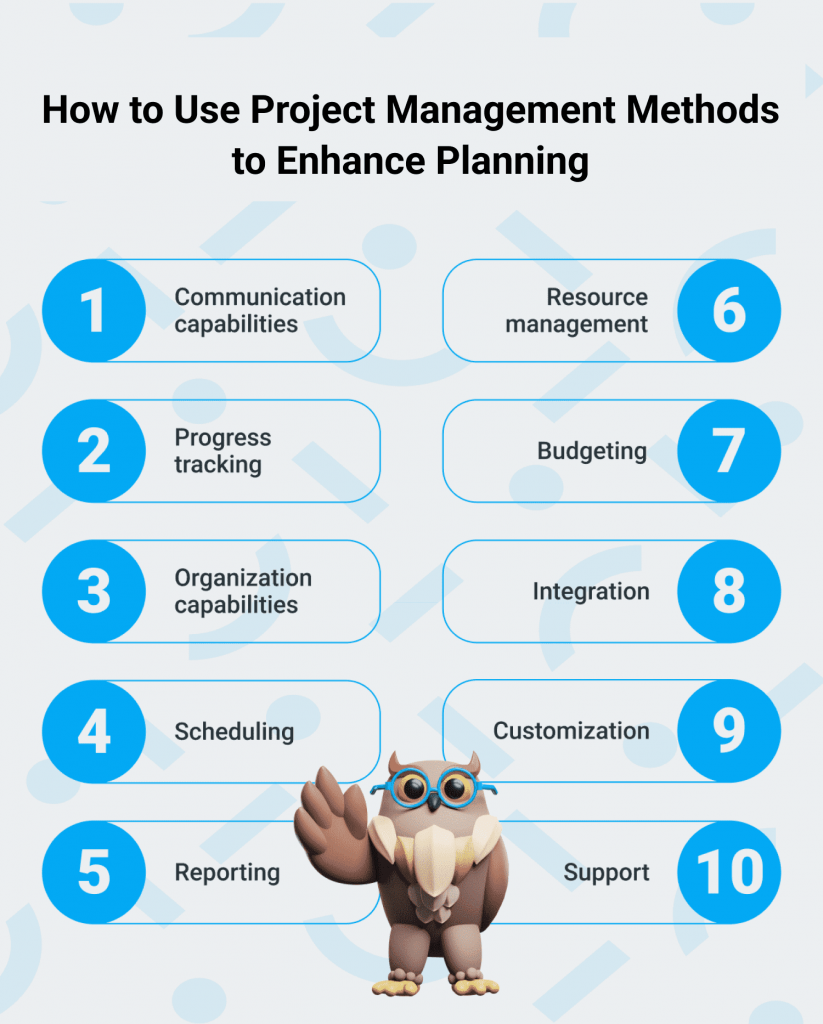According to project management experts, “Strong projects and strategic planning go hand-in-hand.”
Being a part of the industry and having handled several huge projects, I have already experienced this quite often. When a project directly contributes to a company’s long-term goals, the team’s motivation soars, and success becomes a natural byproduct.
But how do you achieve this alignment?
In this blog, I’ll help you understand the practical steps for ensuring your projects are not just about ticking the boxes but strategic project planning your organization forward. We’ll explore how to write a strategic plan for a project, prioritize projects effectively, and foster a culture of alignment within your team.
Let’s get started!
What Is Strategic Project Planning in Project Management?
Before we understand strategic planning, let’s get an idea about project management and how to manage projects online with this video:
Now, let’s proceed to the definition of strategic planning.
Strategic project planning in project management is a comprehensive approach that integrates the organization’s strategic goals with specific projects. It ensures that each project contributes directly to the company’s broader objectives and overall mission. This planning process involves aligning project outcomes with strategic priorities, optimizing resource allocation, and managing risks to maximize benefits.
For example, if a company’s strategic goal is to increase market share by 20% within two years, projects such as developing new products, enhancing customer service, or expanding into new markets should be prioritized.
This alignment helps in efficient resource allocation and ensures that all departments are working towards a common goal, thus avoiding conflicts and waste of resources.
In fact, companies with high strategic alignment and planning are 57% more effective in achieving project outcomes that contribute to business success.
Read More: What Is Project Planning – Steps, Importance, Examples, & More
Why Is Strategic Planning Crucial for Project Management?
Strategic planning is crucial for project management for several reasons, such as:
- Alignment with Organizational Goals: Strategic planning helps ensure that a project is not only feasible but also aligns with the broader objectives and priorities of the organization. This alignment maximizes the impact of the project and ensures it contributes positively to the organization’s overall strategy.
- Resource Optimization: Strategic planning enables effective allocation and utilization of resources, including time, budget, and personnel. By planning strategically, project managers can prioritize resource allocation to the most critical parts of a project, ensuring efficiency and reducing waste.
- Risk Management: Strategic planning involves identifying potential risks and developing mitigation strategies. This proactive approach allows project teams to handle challenges more effectively and reduces the likelihood of project failure.
- Improved Decision-Making: When a project is guided by a clear strategic plan, decision-making becomes more straightforward. Project managers and team members have a clearer understanding of project goals and criteria for decision-making, which helps in resolving issues and making choices that best serve the project’s objectives.
- Enhanced Communication: A strategic plan acts as a communication tool that provides all stakeholders with a clear vision of what the project aims to achieve and how it will be achieved. This clarity enhances collaboration among team members and improves stakeholder engagement.
- Better Performance and Accountability: With a strategic plan, performance metrics can be defined clearly. This allows for regular monitoring and evaluation of the project’s progress against its objectives, fostering a culture of accountability and continuous improvement.
- Future Scalability and Sustainability: Strategic planning focuses on the immediate outcomes and the project’s long-term impact and sustainability. This foresight ensures that projects are scalable and can evolve as organizational needs change.
By integrating strategic planning into project management, organizations can ensure that projects are not only executed efficiently but also contribute to the organization’s long-term success and resilience.
Read More: The Importance of Goal Setting
What Are the Problems in Developing a Strategic Project Plan?

Developing a strategic project plan can be a complex process, fraught with challenges that can hinder the project’s success. Here are some common problems encountered during the planning phase, along with potential solutions for each:
1. Unclear Goals and Objectives
A project may struggle from the start if its goals and objectives are not clearly defined. Ambiguous goals can lead to misaligned team efforts and ineffective resource allocation.
Solution: Define clear, measurable, and achievable goals at the outset. Use the SMART criteria (Specific, Measurable, Achievable, Relevant, Time-bound) to ensure each goal meets these standards.
2. Lack of Stakeholder Engagement
Insufficient stakeholder engagement can result in a lack of support, leading to potential challenges in project execution and alignment.
Solution: Regularly involve stakeholders through meetings, updates, and decision-making processes to ensure their needs are met and their support is maintained.
3. Inadequate Risk Management
Failing to identify or underestimate risks can derail a project unexpectedly.
Solution: Conduct thorough risk assessments during the planning phase and continue to evaluate risks throughout the project. Develop contingency plans for identified risks.
4. Resource Constraints
Limited or poorly allocated resources (time, budget, personnel) can impede project progress.
Solution: Plan meticulously to ensure optimal allocation of resources. Use resource management tools and techniques to monitor and adjust allocations as needed.
5. Ineffective Communication
Poor communication can lead to misunderstandings, conflicts, and delays in a project.
Solution: Establish a clear communication plan that specifies who will receive what information, when, and through which channels. Encourage open lines of communication across all levels of the team.
6. Resistance to Change
Change resistance from team members or other stakeholders can stall or even halt progress.
Solution: Manage change effectively by preparing stakeholders for changes, communicating the benefits clearly, and providing necessary training or support to adapt to new ways of working.
7. Insufficient Skills or Expertise
The project team may lack the necessary skills or expertise required to complete the project successfully.
Solution: Identify skill gaps early and address them through training, hiring, or outsourcing. Regularly assess team capabilities and adapt as necessary.
8. Unrealistic Timelines
Setting unrealistic timelines can lead to rushed work, low quality, and burnout.
Solution: Set realistic timelines based on careful estimation and historical data. Regularly review and adjust the project calendar based on actual progress.
9. Poor Project Scope Management
Scope creep can extend the project beyond its original boundaries, impacting budget and timelines.
Solution: Clearly define the project scope and use scope management practices to control deviations. Ensure scope changes are formally processed through change management procedures.
10. Lack of Project Adaptability
Inflexibility in responding to changes or unexpected issues can impede progress.
Solution: Adopt agile methodologies or incorporate flexibility into the project plan to allow for adjustments in response to changing conditions or insights gained during the project lifecycle.
By addressing these challenges with targeted solutions, a strategic project plan can be more effectively developed and executed, leading to increased chances of project success.
Read More: Agile Planning: What Is, Its Characteristics, & How It Works
How to Plan Projects With Strategic Objectives
Aligning projects with strategic objectives is crucial for ensuring that an organization’s resources are invested in initiatives that advance its overarching goals.
Here are key strategies to help better understand and implement this alignment:
1. Define Clear Strategic Objectives
Strategic objectives should be clearly defined and communicated across the organization. For instance, a study by the Project Management Institute (PMI) suggests that projects are 57% more likely to achieve their objectives and 50% more likely to finish on time and on budget when the organization’s strategy is clearly communicated to all team members.
2. Use a Project Planning Tool
Using a project planning tool can make a big difference in your work. It helps you organize tasks, keep track of progress, and work better with your team. This can lead to more successful projects that finish on time and meet all your goals. For example, IBM uses technology dashboards to visually align projects with their strategic goals, helping managers make informed decisions about project prioritization.
3. Establish Governance Structures
Effective governance structures, such as steering committees or project management strategic planning offices, ensure that projects are continuously evaluated against strategic objectives. According to PMI, organizations with a PMO report that 38% more projects meet original goals and business intent.
4. Conduct Regular Reviews
Regular project reviews and audits are critical to ensure projects remain aligned with strategic objectives. These reviews can help identify misalignments early, allowing for timely adjustments. For example, Cisco conducts quarterly business reviews that assess project performance against strategic goals, leading to adjustments in project execution as needed.
5. Invest in Project Management Training
Training project managers in strategic planning skills is crucial. A report from PMI shows that organizations that invest in ongoing project manager training see better project success rates than those that don’t. This training helps managers understand how to align project outcomes with broader organizational goals.
6. Foster Communication and Collaboration
Encouraging open communication and collaboration between project teams and strategic planners ensures alignment throughout the project lifecycle. Google, for example, uses cross-functional teams to ensure that different departments work together towards common strategic objectives.
7. Utilize Performance Metrics
Implementing specific metrics that directly relate projects to strategic goals can guide teams and provide quantitative measures of alignment. Companies like Amazon use key performance indicators (KPIs) specific to strategic goals to measure project success and impact on company objectives.
8. Prioritize Projects Based on Strategic Impact
Projects should be selected and prioritized based on their potential impact on strategic objectives. For instance, during the 2008 financial crisis, Toyota prioritized projects that increased operational efficiency and reduced costs, directly supporting its strategic objective of financial stability.
9. Adapt and Evolve Strategy
Strategic objectives may evolve, and projects must be flexible to adapt. Regular strategic reviews can help organizations pivot as necessary. Apple frequently reviews its project portfolio to adapt to changing technology trends, ensuring that its projects align with its evolving strategic goals.
Read More: Why Differentiate Between Project Goals and Objectives?
How to Use Project Management Methods to Enhance Planning

Using project management methods for planning in an organization or team can greatly improve the efficiency and effectiveness of project delivery.
Here are several key methods and practices that can help you achieve this:
Agile Methodology
Agile methodology is particularly effective for teams that need flexibility and frequent reassessment of tasks aligned with changing demands or priorities. It encourages collaboration and quick responses to change through regular scrums or stand-ups where teams can align daily on their tasks and hurdles.
Scrum Framework
A subset of Agile, the Scrum framework involves short sprints of work, which allow teams to adjust quickly and realign as needed. Regular sprint planning, reviews, and retrospectives ensure continuous pace with the project goals and client needs.
Kanban
This method focuses on visualizing the workflow, often with a Kanban board, which helps to align the team on the status of various tasks and manage work in progress effectively. It allows teams to see bottlenecks early and adjust their efforts accordingly.
Waterfall Methodology
The Waterfall methodology provides a sequential approach for projects with clear, fixed stages and requirements. This can help in aligning the team’s expectations and efforts at each stage of the project, ensuring a systematic progression towards the project goals.
Lean Management
Lean principles focus on value creation with less waste. This approach aligns the team’s efforts on elements that directly add value to the project, helping to prioritize tasks more effectively.
Project Management Tools
Tools like ProProfs Project, JIRA, Asana, or Trello can be instrumental in enhancing the plans. They help in planning, scheduling, and tracking progress, ensuring that everyone is aware of their tasks and deadlines.
Regular Check-ins and Updates
Regular meetings, such as daily stand-ups or weekly catch-ups, depending on the project needs, ensure continuous alignment. These meetings help teams to stay updated on the progress, discuss any challenges, and realign their efforts as needed.
Clear Communication Channels
Establishing clear lines of communication is vital for planning. This includes not only formal reporting structures but also informal communication that can help in resolving issues more quickly and maintain team cohesion.
Stakeholder Management
Regularly engaging with stakeholders and updating them on progress can help manage expectations and align project outcomes with stakeholder needs. This is particularly important in complex projects where multiple interests and perspectives need to be balanced.
Risk Management
Proactively managing risks by identifying potential pitfalls ahead of time and planning how to mitigate them can keep a project on track and maintain strategic plans.
By applying these project management methods, teams can improve their planning internally and with their stakeholders and the organization’s overall strategic goals.
Master Strategic Planning With Smart Project Management Tools
Implementing strategic planning in project management is essential for driving organizational success and ensuring that every project contributes to your broader business objectives. By fostering open communication, aligning goals across departments, and regularly reviewing and adjusting strategies, you can maintain a clear path towards your vision.
These days, the effective use of robust project management tools is crucial, and tools like ProProfs Project offer comprehensive features such as real-time dashboards, automated task scheduling, and easy file sharing to enhance transparency, foster seamless collaboration, and streamline workflows.
This ensures that teams are consistently aligned with strategic goals, facilitating timely decision-making and ultimately boosting project efficiency and success.
Learn More About Strategic Project Planning
What are the 7 steps of project planning?
The seven steps of project planning include:
- defining project objectives
- identifying deliverables
- planning the schedule
- allocating resources
- assessing risks
- executing the plan, and
- monitoring and controlling progress
These steps help ensure that a project is completed on time, within budget and meets the desired quality standards.
What is the difference between project and strategic management?
Project management focuses on the execution of specific projects within time, budget, and scope constraints, often with immediate and tangible outputs. Strategic management, on the other hand, involves setting long-term goals, developing policies, and allocating resources to achieve these goals. It is broader in scope and aims to align organizational activities with overall objectives.
What are the 4 P’s of strategic planning?
The 4 P’s of project management and strategic planning are Purpose, Planning, Positioning, and Performance.
- Purpose defines the mission and vision of the organization.
- Planning involves outlining strategies and actions to achieve the vision.
- Positioning determines how the organization differentiates itself in the market.
- Performance measures the effectiveness of strategies and the progress towards objectives.
Read More: 15 Best Project Planning Tools and Software List
Why is project planning and strategic management important?
Project planning and strategic management are crucial as they provide a structured approach to achieving business goals. Project planning ensures that resources are efficiently used and projects are delivered successfully. Strategic management helps in setting long-term goals and aligning resources and operations with these goals. Together, they foster organizational growth, competitiveness, and adaptability.
FREE. All Features. FOREVER!
Try our Forever FREE account with all premium features!





